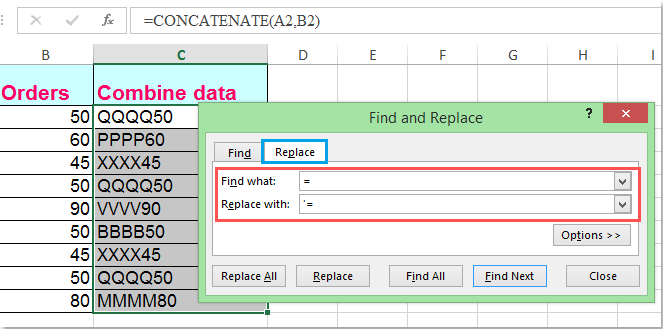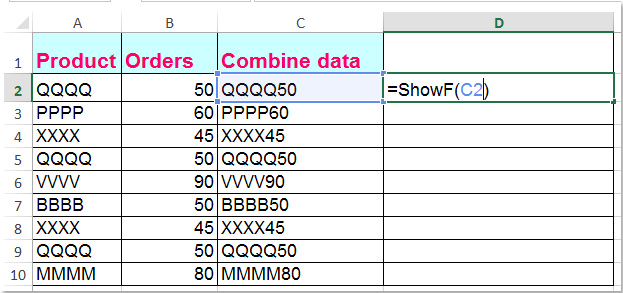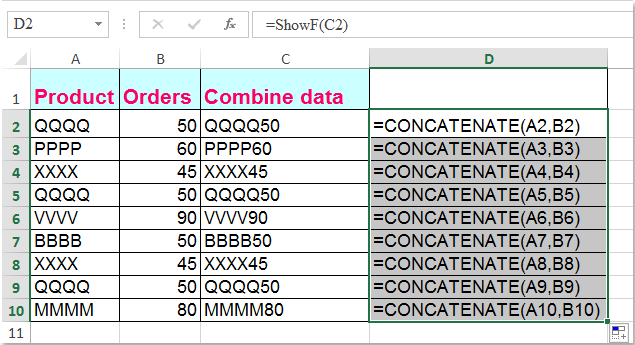¿Cómo convertir una fórmula en una cadena de texto en Excel?
Normalmente, Microsoft Excel mostrará los resultados calculados cuando ingresas fórmulas en las celdas. Sin embargo, a veces puede que necesites mostrar solo la fórmula en la celda, como =CONCATENAR("000", " - 2"), ¿cómo lo manejarías? Hay varias formas de resolver este problema:
Convertir fórmula a cadena de texto con la función Buscar y Reemplazar
Convertir fórmula a cadena de texto o viceversa con un solo clic
Convertir fórmula a cadena de texto con una Función Definida por el Usuario
Convertir fórmula a cadena de texto con la función Buscar y Reemplazar
Supongamos que tienes un rango de fórmulas en la Columna C, y necesitas mostrar la columna con las fórmulas originales pero no sus resultados calculados, como se muestra en las siguientes capturas de pantalla:
 |  |
Para resolver esta tarea, la función Buscar y Reemplazar puede ayudarte, por favor sigue estos pasos:
1. Selecciona las celdas con los resultados calculados que deseas convertir en cadenas de texto.
2. Luego presiona las teclas Ctrl + H juntas para abrir el cuadro de diálogo Buscar y Reemplazar; en el cuadro de diálogo, bajo la pestaña Reemplazar, introduce el signo igual = en el cuadro de texto Buscar lo siguiente, e introduce '= en el cuadro de texto Reemplazar con, ver captura de pantalla:

3. Luego haz clic en el botón Reemplazar Todo, podrás ver que todos los resultados calculados se han reemplazado con las cadenas de texto de las fórmulas originales, ver captura de pantalla:

Convertir fórmula a cadena de texto o viceversa con un solo clic
Si tienes Kutools para Excel, con su función Convertir Fórmula a Texto, puedes cambiar múltiples fórmulas a cadenas de texto con un solo clic.
Después de instalar Kutools para Excel, por favor haz lo siguiente:
1. Selecciona las fórmulas que deseas convertir.
2. Haz clic en Kutools > Texto > Convertir Fórmula a Texto, y tus fórmulas seleccionadas se habrán convertido en cadenas de texto al instante, ver captura de pantalla:

Consejos: Si deseas convertir las cadenas de texto de las fórmulas de vuelta a los resultados calculados, simplemente aplica la utilidad Convertir Texto a Fórmula como se muestra en la siguiente captura de pantalla:

¡Descarga y prueba gratis Kutools para Excel ahora!
Convertir fórmula a cadena de texto con una Función Definida por el Usuario
El siguiente código VBA también puede ayudarte a resolverlo fácilmente.
1. Mantén presionadas las teclas Alt + F11 en Excel, y se abrirá la ventana Microsoft Visual Basic para Aplicaciones.
2. Haz clic en Insertar > Módulo, y pega la siguiente macro en la Ventana del Módulo.
Function ShowF(Rng As Range)
ShowF = Rng.Formula
End Function
3. En una celda en blanco, como la Celda D2, introduce la fórmula =ShowF(C2).

4. Luego haz clic en la Celda D2, y arrastra el Controlador de Relleno ![]() hasta el rango que necesites.
hasta el rango que necesites.

Las mejores herramientas de productividad para Office
Mejora tu dominio de Excel con Kutools para Excel y experimenta una eficiencia sin precedentes. Kutools para Excel ofrece más de300 funciones avanzadas para aumentar la productividad y ahorrar tiempo. Haz clic aquí para obtener la función que más necesitas...
Office Tab incorpora la interfaz de pestañas en Office y facilita mucho tu trabajo
- Habilita la edición y lectura con pestañas en Word, Excel, PowerPoint, Publisher, Access, Visio y Project.
- Abre y crea varios documentos en nuevas pestañas de la misma ventana, en lugar de hacerlo en ventanas separadas.
- ¡Aumenta tu productividad en un50% y reduce cientos de clics de ratón cada día!
Todos los complementos de Kutools. Un solo instalador
El paquete Kutools for Office agrupa complementos para Excel, Word, Outlook y PowerPoint junto con Office Tab Pro, ideal para equipos que trabajan en varias aplicaciones de Office.
- Suite todo en uno: complementos para Excel, Word, Outlook y PowerPoint + Office Tab Pro
- Un solo instalador, una licencia: configuración en minutos (compatible con MSI)
- Mejor juntos: productividad optimizada en todas las aplicaciones de Office
- Prueba completa de30 días: sin registro ni tarjeta de crédito
- La mejor relación calidad-precio: ahorra en comparación con la compra individual de complementos